For me these Blue Jay Photos are both a high and a low of sorts. Readers know I don’t bait or use setups on birds and it’s been my practice to only photograph birds at my feeders for practice or to test my equipment. Not shooting at feeders isn’t a hard and fast rule for me but it’s one I’ve followed on my blog so far (though I’ve been sorely tempted to photograph birds at my feeders because lately they’ve been so very scarce anywhere else around here). For me baiting raptors in particular is an ethical issue but not shooting setups or at feeders is only a strong personal preference, though in my opinion setups can become an ethical issue when they aren’t disclosed.
Blue Jays in Utah are a pretty big deal. To call them rare as I implied in my title is probably a bit of a stretch. Officially they’re listed as “occasional winter visitors” but that descriptor was too long and awkward for my title so I went with rare. But this late fall and early winter across much of the west, including Utah, there’s been a region-wide irruption of Blue Jays and I’ve been wanting to photograph them for weeks now. If that meant shooting at feeders, so be it.
So yesterday morning for the fourth time recently I visited some feeders on the east side of Salt Lake Valley (a private residence) and finally got a few documentary shots.
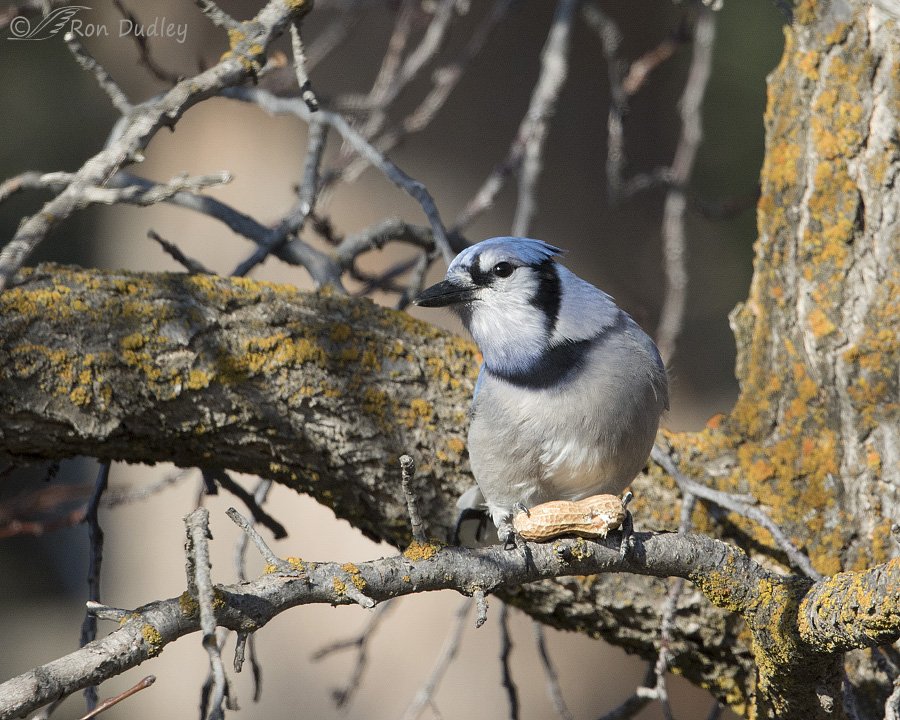
1/1600, f/6.3, ISO 800, Canon 7D Mark II, Canon EF 500mm f/4L IS II USM + EF 1.4 III Extender, photo taken near a feeder
I was shooting from the street from my pickup and the jays never came in very close but this one grabbed a peanut at the feeder and landed closer than any of the others. This species is a lifer for me so I was happy to get the photos – feeders or not.
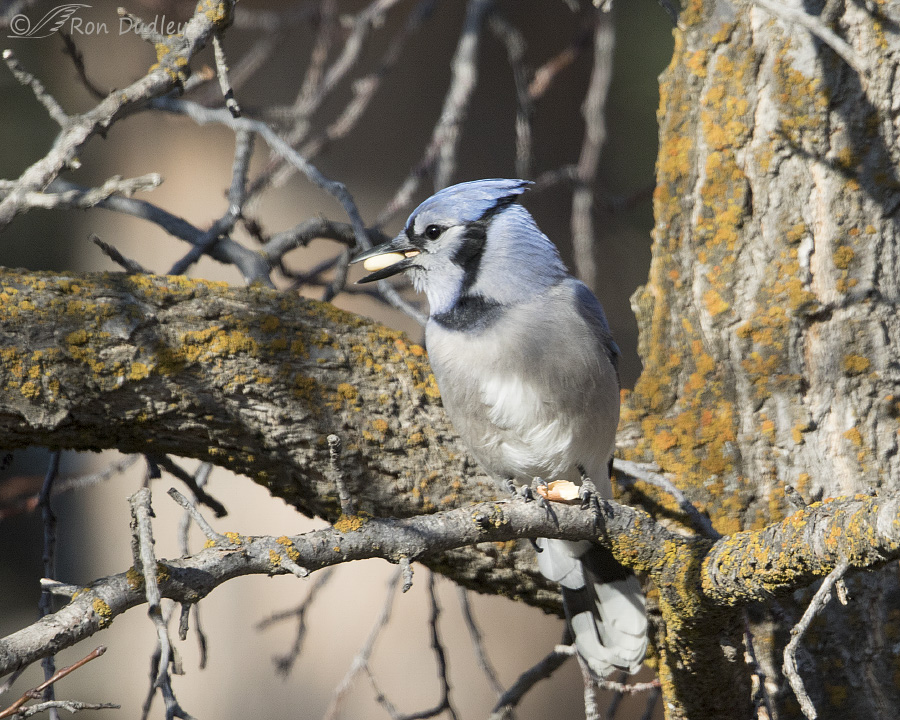
1/2000, f/6.3, ISO 800, Canon 7D Mark II, Canon EF 500mm f/4L IS II USM + EF 1.4 III Extender, photo taken near a feeder
It only gave me a few shots and then it was gone.
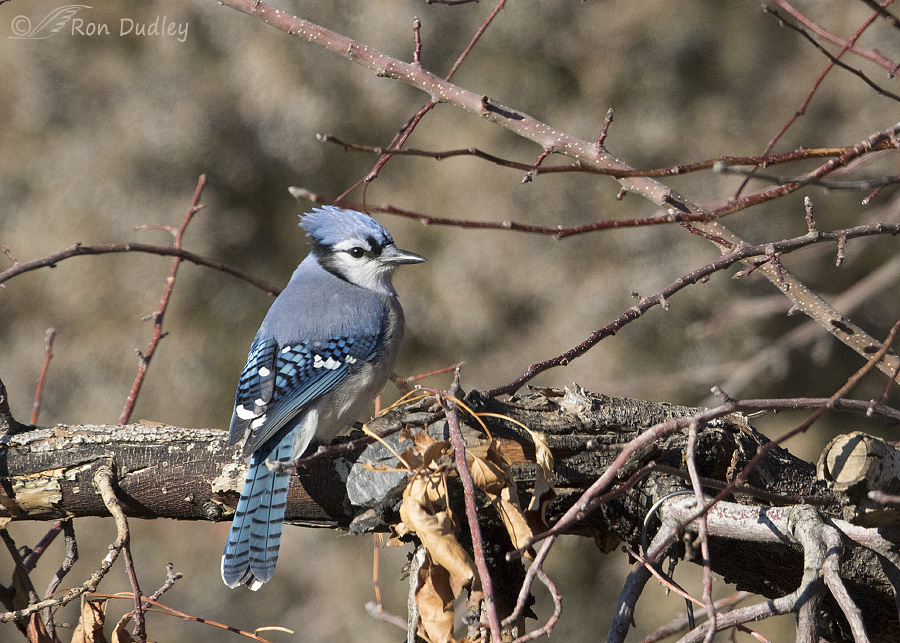
1/3200, f/6.3, ISO 800, Canon 7D Mark II, Canon EF 500mm f/4L IS II USM + EF 1.4 III Extender, photo taken near a feeder
This was probably my best photo of the morning. What beautiful colors and plumage patterns they have! For many of my eastern readers Blue Jays are probably fairly ho-hum but this was a notable event for me so I had to include it in today’s post.
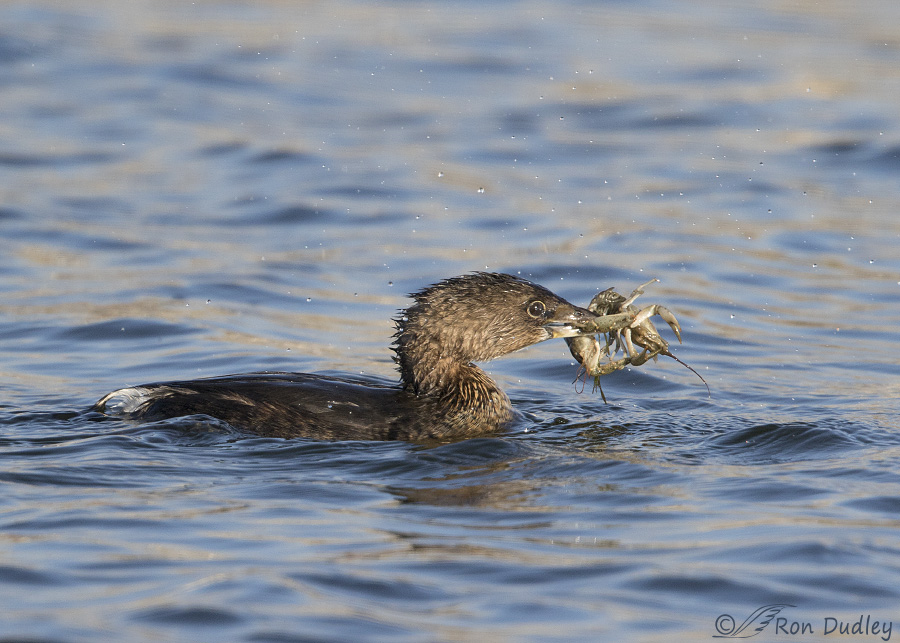
1/2000, f/6.3, ISO 640, Canon 7D Mark II, Canon EF 500mm f/4L IS II USM + EF 1.4 III Extender, not baited, set up or called in
Then later in the day I visited a local pond and had some fun with Pied-billed Grebes as they beat the hell out of crayfish before swallowing them. The following from Birds of North America Online about Pied-billed Grebes describes what I saw perfectly:
- “Bill is powered by strong jaw muscles, enabling bird to capture and crush hard-bodied crustaceans, especially crayfish, which form a substantial part of its diet.”
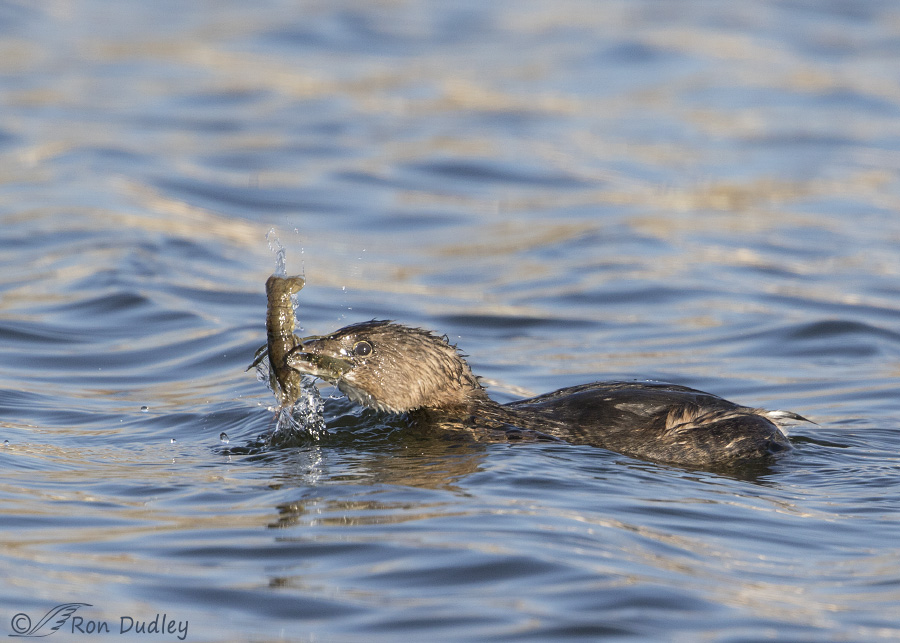
1/2000, f/6.3, ISO 640, Canon 7D Mark II, Canon EF 500mm f/4L IS II USM + EF 1.4 III Extender, not baited, set up or called in
Here the grebe is in the process of tearing off one of the claws (the claw with its attached appendage is called a cheliped – this old zoology teacher had to include that…). After this shot the crayfish was quickly swallowed.
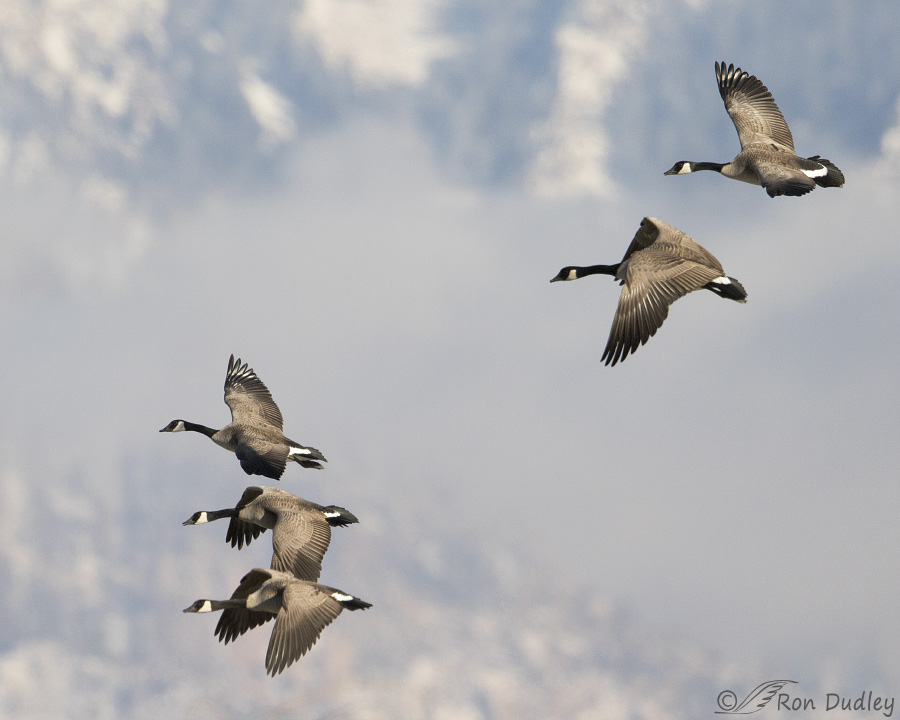
1/6400, f/6.3, ISO 640, Canon 7D Mark II, Canon EF 500mm f/4L IS II USM + EF 1.4 III Extender, not baited, set up or called in
At that point a flock of Canada Geese flew in to land on the pond so I quickly raised my lens and fired off a few shots as they crossed in front of the nearby Wasatch Mountains that were partially shrouded in clouds. As evidenced by my shutter speed I didn’t have time to make any adjustments to my camera settings.
But I digress so back to the grebes.
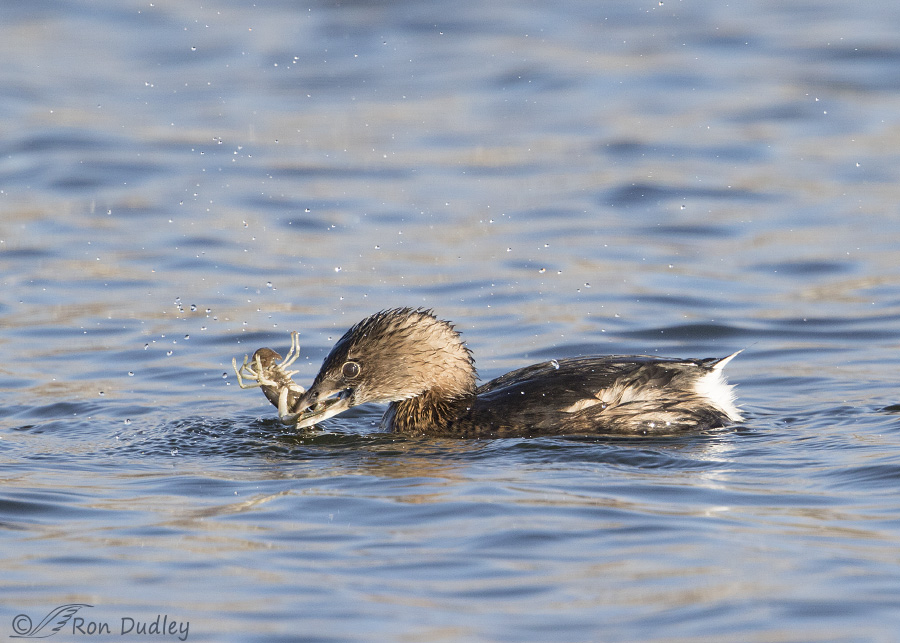
1/2500, f/6.3, ISO 800, Canon 7D Mark II, Canon EF 500mm f/4L IS II USM + EF 1.4 III Extender, not baited, set up or called in
Soon another grebe caught another crayfish.
1/2000, f/6.3, ISO 800, Canon 7D Mark II, Canon EF 500mm f/4L IS II USM + EF 1.4 III Extender, not baited, set up or called in
This grebe must have read what BNA Online says about how they handle crayfish because it followed the script perfectly.
- “Pinches and handles crayfish as it does fish (killing them by damaging internal organs). Removes larger claws by holding appendage in bill just behind claw, and vigorously shaking until claw breaks off. Swallows crayfish tail first; remaining appendages fold alongside prey body, facilitating swallowing.”
In this photo the grebe has just pulled off one of the claws before swallowing it as the crayfish appears to defend itself with the other one.
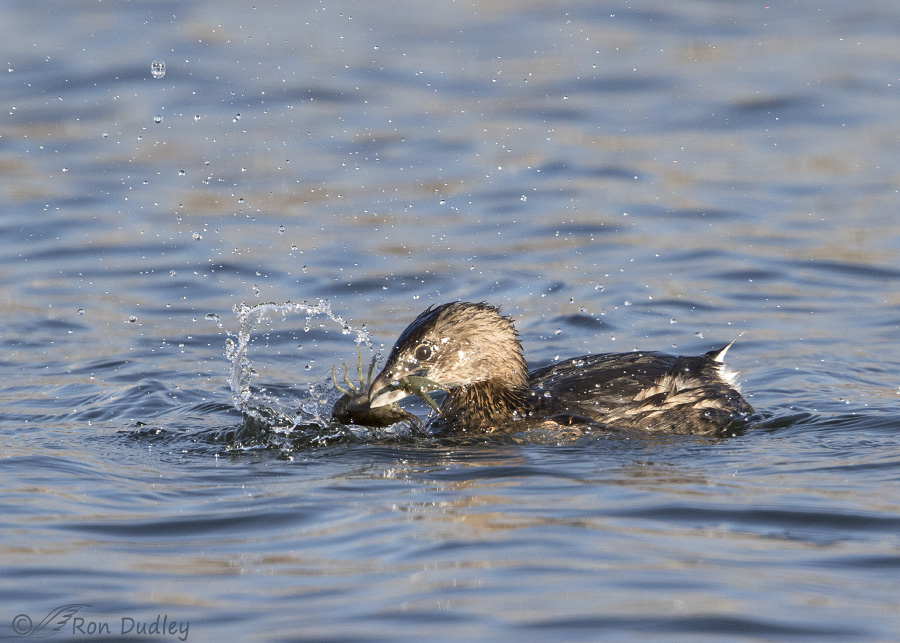
1/2500, f/6.3, ISO 800, Canon 7D Mark II, Canon EF 500mm f/4L IS II USM + EF 1.4 III Extender, not baited, set up or called in
Then it immediately went to work on the other claw. When they shake their prey the action is incredibly fast so I wish I’d had a faster shutter speed to get a little less motion blur on the crayfish but it isn’t too bad.
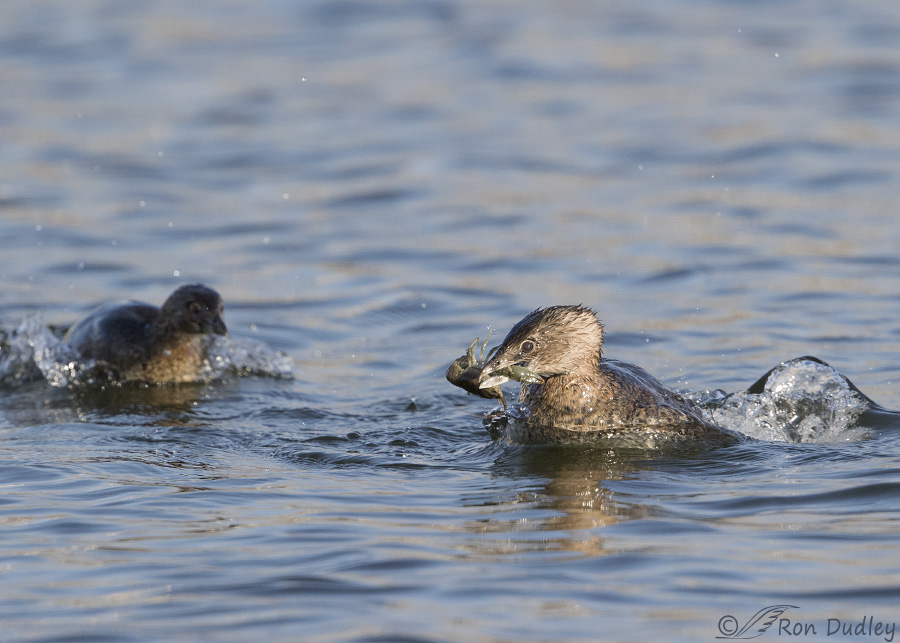
1/2500, f/6.3, ISO 800, Canon 7D Mark II, Canon EF 500mm f/4L IS II USM + EF 1.4 III Extender, not baited, set up or called in
But before it was able to get the claw torn off along came trouble – in the form of another grebe intent on stealing the meal. When the second grebe appeared in my viewfinder (I didn’t even know it was there) I instinctively fired off a quick burst to see what I might capture.
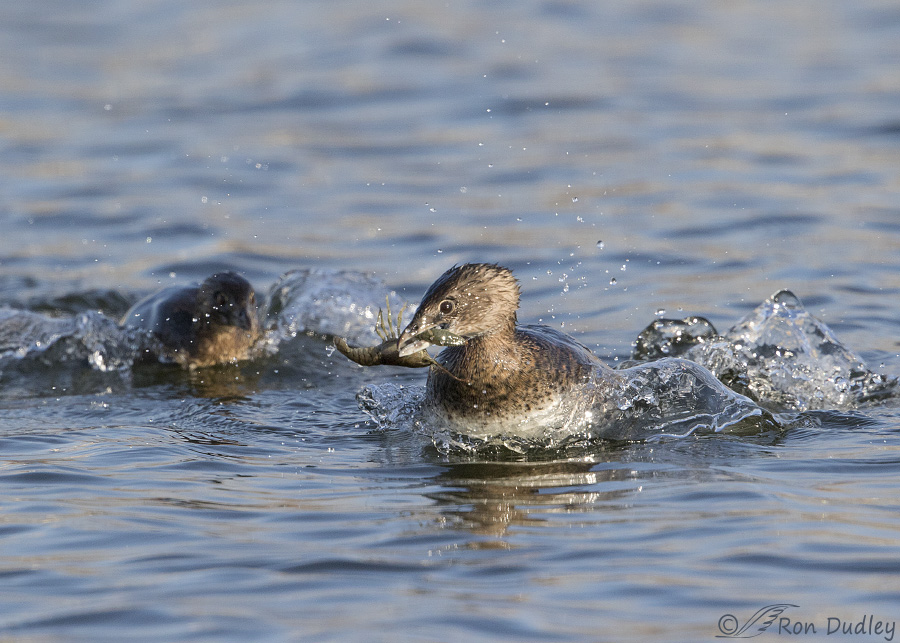
1/3200, f/6.3, ISO 800, Canon 7D Mark II, Canon EF 500mm f/4L IS II USM + EF 1.4 III Extender, not baited, set up or called in
The first grebe fired its afterburners…
1/3200, f/6.3, ISO 800, Canon 7D Mark II, Canon EF 500mm f/4L IS II USM + EF 1.4 III Extender, not baited, set up or called in
in an attempt to escape with the fish while the attacking grebe dived at the last second (this species often prefers to attack underwater).
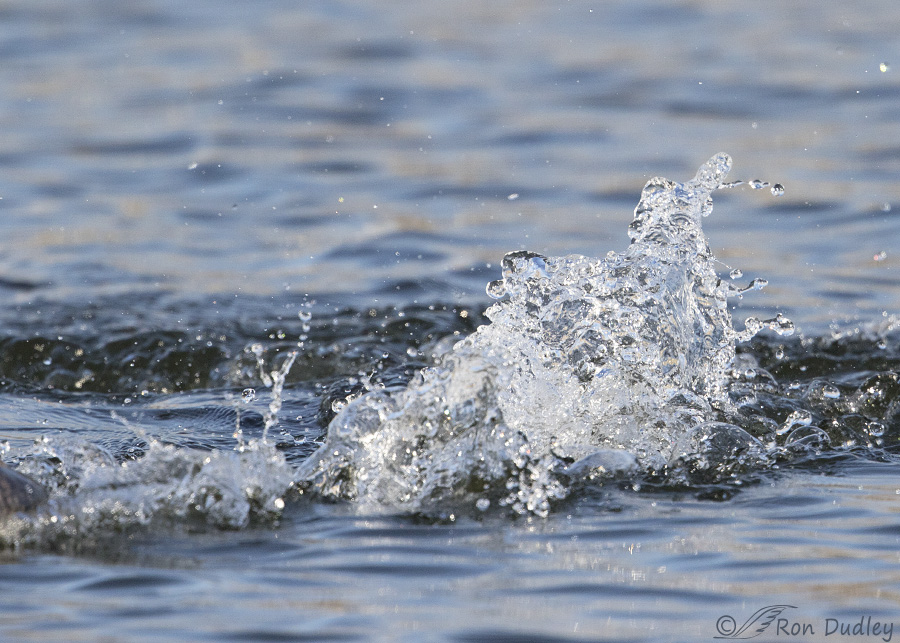
1/5000, f/6.3, ISO 800, Canon 7D Mark II, Canon EF 500mm f/4L IS II USM + EF 1.4 III Extender, not baited, set up or called in
The action was so fast that most of what I captured was the water splash of the fleeing grebe with just a hint of its rump at lower left.
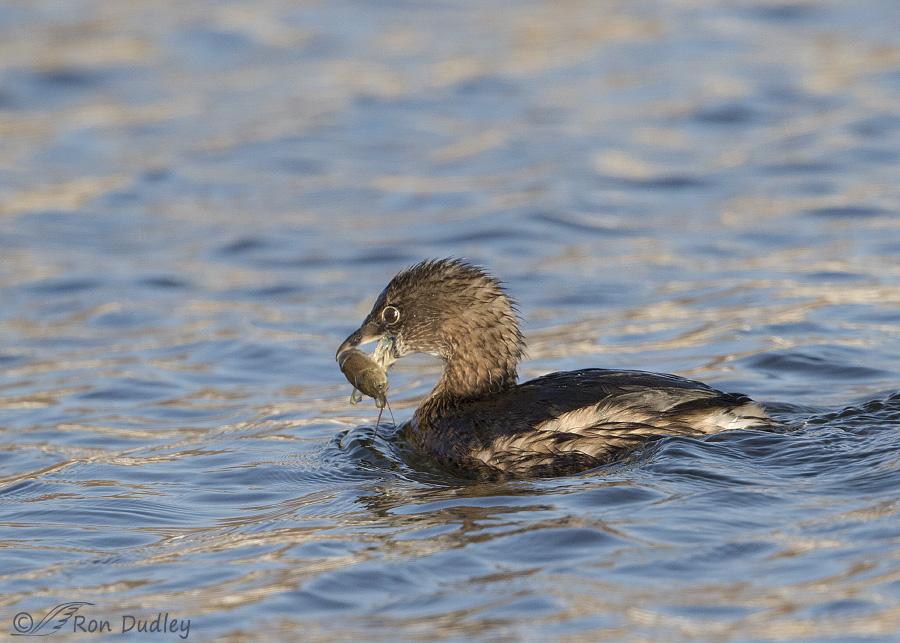
1/2500, f/6.3, ISO 800, Canon 7D Mark II, Canon EF 500mm f/4L IS II USM + EF 1.4 III Extender, not baited, set up or called in
By the time I was able to get my lens on the original grebe again it was about to swallow the now clawless crayfish.
All in all it was a more productive day than I thought it was going to be. First Blue Jays and then grebes tearing apart and fighting over crayfish. And it isn’t every day that I get a lifer.
Ron


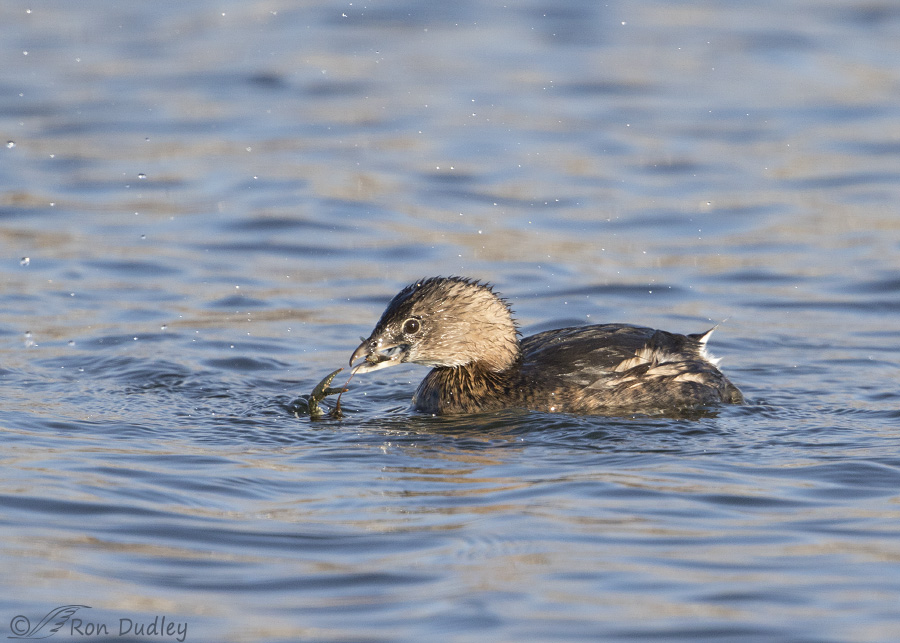
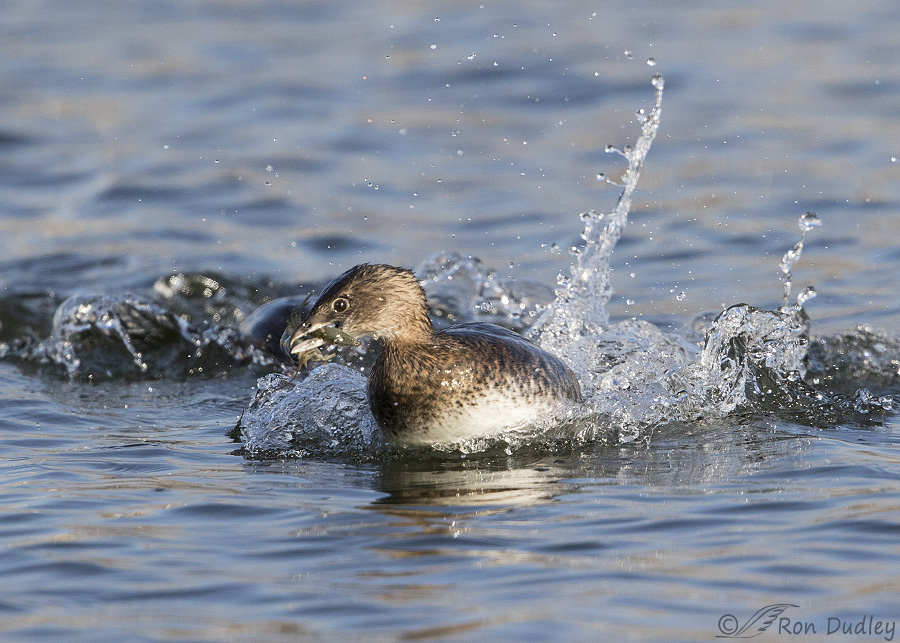
I love jays. Have a family in my yard. I never get to see the scrub jays or stellar Jays.
I never get to see the scrub jays or stellar Jays.
Blue Jays are my favorite, don’t see as many in NC as when I was growing up in the Charlotte area…..
Ron, I again enjoyed your ‘teaching moment’. We have 2 kinds of jays in our back yard. I now know that scrub jays are prominent here along with a few sightings of blue jays. I mistakenly thought that the blue jay was a steller’s jay. So happy to have cleared that up, thanks to you!!
The grebe’s are something to behold. How fascinating to see photos of them tearing away at the claws on the crayfish.
Thank you for a great series and your ‘stories’.
Alice, there were Stellers, Blue and Scrub jays at these feeders while I was there. Pretty fun to watch.
HUGE smiles. For which I give grateful thanks.
And my usual dose of awe and wonder.
Thank you, EC.
Great blue jay shots, Ron! So exciting to get a lifer — woo hoo! I’m looking forward to watching “our” scrub jays nesting again this spring. One of the adults always stops by the clerestory windows to say hi on its way to the nest.
I’m looking forward to watching “our” scrub jays nesting again this spring. One of the adults always stops by the clerestory windows to say hi on its way to the nest.
Fascinating grebe series too. That guy’s got some wheels! Glad he was eventually able to enjoy his meal in pieces…er…peace.
“That guy’s got some wheels!”
I like that, Marty. I may steal it for some future grebe post…
Any time! Happy to contribute.
Good morning, Ron! The Blue Jay is very attractive & certainly wish I could see one live but your pictures will have to do. We see lots of Steller’s Jays here and I get sworn at if the Peanut tray is empty. Then of course the Squirrel comes & chases the Steller’s Jay. Remembering your post on Nov. 30th of the Northern Pygmy-Owl, I saw my first Owl yesterday, it was a Northern Pygmy-Owl & in spite of the horrible lighting I got one fairly decent shot of this little one. We are now starting to see more Grebes around here but I believe they may be the Horned Grebe, too far off to really see. So thank you for the great post & the lesson on the way the Grebe has lunch.
Wow, a Northern Pygmy Owl. Congrats, Shirley!
Thanks for the interesting info and photos of the grebes and blue jays. When I was a pre-teen I went out to photograph birds. Came upon a blue jay and figured out where the nest was and went quite close to photograph it with my 135 or 110 camera and the eggs (I know better now). Mom did not appreciate me coming that close, attacked my head, and drew blood! It was then a badge of honor! This was in Minnesota where blue jays are everywhere.
Interesting story, Beth. I knew jays can be aggressive in certain situations but I didn’t know they’d actually attack a human. Nest defense is a pretty strong instinct.
I was about 4 feet from the nest so fully deserved the attack!
We see a lot of Blue Jays…always noisy. always hungry, always fun to watch, beautiful to see…some make unique calls. One cheeps like a baby chick, one shrieks, one imitates a hawk, making other birds scatter and leaving the feeder to himself. Glad you saw one. Images are beautiful. Images of crayfish being beaten senseless are interesting…as usual, I feel pretty darned sorry fir the prey….
Patty, these jays were pretty noisy too. There were also Stellers and Scrub Jays at the feeder and between them it was pretty interesting.
Having finally seen a Pied-billed Grebe at the park, I understand completely about seeing a lifer – that one Grebe was that for me. And after looking at these photos I can’t help but wonder what they eat when they are in our neighborhood. The best we can do for them is some of our freshwater shrimp, which are tiny compared to the crayfish. For me Blue Jays are ordinary, having lived in the east, but I have to agree that they have beautiful markings. Thank you for including the Canada Geese – I’m always happy to see them.
Susan, they’re highly opportunistic when it comes to size and kind of prey. Besides small fish and crustaceans they also eat aquatic insects and their larvae and there’s usually lots of them available in fresh water ponds and streams.
Beautiful Blue Jay. I have a feeder and can only hope I get one at mine. I love color and birds and when they are combined it is great. The grebe story was great as well.
Good luck getting a Blue Jay, Betty. Thanks.
Marvelous series Ron!
Charlotte
Thanks, Charlotte.
When living in mountains of New Mexico I had only one Blue Jay visit my yard over 11 years. Never had a robin, either. Funny how we may not appreciate the beauty of “common” birds as much as when they are rare or scarce.
“Funny how we may not appreciate the beauty of “common” birds as much as when they are rare or scarce.”
That is so very very true, Ken.
I am an Eastener and have always admired the beauty of blue jays. They are spectacular looking and I love their sauciness. About 10 or so years ago, when we first heard of West Nile the jays were few and far between in these parts for a couple of years. I was not a bird watcher or photographer then, but I loved hiking and was always remarking to my friends about their disappearance. It was very depressing that these birds of my childhood were gone.
But they came back, and with a vengeance! Ha ha. And although they are ever-present around here now, I never take them for granted. They are actually hard to photograph… the minute you move your camera they are off – they know you are up to something. So I say bravo to you – those jay pictures are quite nice. And of course the grebe photo’s are beautiful and interesting!
Interesting, Joanne. It sounds like Blue Jays have share some of the same shyness that other jays can have.
I’m a native of the mountains and valleys of Utah, and I’d never seen a Bluejay before, either…….just exquisite ! Thanks for capturing it.
Kris, lots of bird neophytes around here call our Western Scrub Jays “blue jays”. A good friend called me yesterday while I was on these birds and when I told him I was photographing Blue Jays at first he assumed I meant scrub jays. He was pretty excited when I told him they really were actual Blue Jays.
Truly fascinating about the ‘Jay Birds’ as some old Southerners call them! I missed them for two years here at my Georgia home! They are back now, not in number I remember as a child however. You got some pretty shots!
Thank you, Alisa.
Very cool!! Wasn’t aware that Blue Jay would be a lifer for you. Shows what is common in one place is not necessarily so in another.
Great series with the Grebe I love the progression of shots – Man they are fast with their bill and movement in water. In the past all I’ve gotten is a blur and had to delete the photos.
“Man they are fast with their bill and movement in water”
They sure are, Dick! When they shift into high gear no matter what they’re doing they’re almost unbelievably fast.
Cool! Wonderful series on the Grebe – don’t want one to pinch a finger for sure – and sure enjoy the jays. We had a small flock of Blue Jays about a month ago and one has stayed behind – a sunflower seed junkie it appears. Also interesting is it appears to stuff it cheeks at the feeder and then go somewhere to shell and eat them. I’ve seen it beat one on a branch as the chickadees do. Highwood, about 6 miles N of us, has some this year also. It’s been many years since we had any – they are unusual here for sure.
Also interesting is it appears to stuff it cheeks at the feeder and then go somewhere to shell and eat them. I’ve seen it beat one on a branch as the chickadees do. Highwood, about 6 miles N of us, has some this year also. It’s been many years since we had any – they are unusual here for sure.
Judy, I suspect folks back east might not appreciate our excitement out here over Blue Jays but not only had I never photographed one, I’d never even seen one before. And after 10 years of photographing birds I don’t get a lifer every day…
It’s always fun to have something “new”. When I lived in San Diego for a few years – late 60’s early 70’s – we had some kind of Jay that was hell on cats………. The few we had many years ago here were the first I’d seen.
When I lived in San Diego for a few years – late 60’s early 70’s – we had some kind of Jay that was hell on cats………. The few we had many years ago here were the first I’d seen.
“we had some kind of Jay that was hell on cats”
Ha, I knew there must be some reason I like jays so much…
Hey!
Just joshin’ you, Judy. I really don’t hate cats. I’m just not much of a cat person…
Thot that might get a smile out of you………….:) I love cats tho they, like anything else, can become an issue in large numbers in the wrong place!
Thanks, Ron. What an amazing series of photos. I, of course, don’t find fault with any of them. Great work! Cindy
I’m glad you like them Cindy. Thanks.